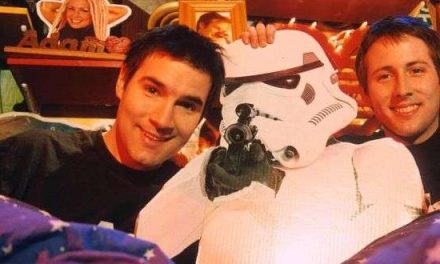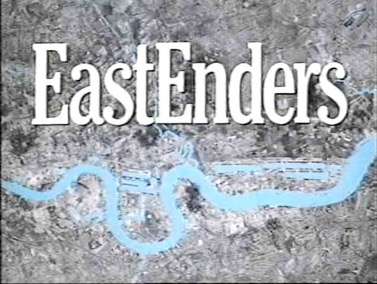
The first episode of EastEnders was broadcast on BBC1 on 19 February 1985. Created by Tony Holland and Julia Smith, the serial is set in the fictional London borough of Walford. It is shot on a purpose-built outside set at Elstree Studios and also interior television studios on the site. The task of the first episode of any soap is to introduce location, characters and storylines, and to set a tone for the drama. This blog post is about just one visual strategy used very frequently by director Matthew Robinson in the first episode of EastEnders to do these things by spatial, compositional means.
The opening sequence shows the discovery of an old man, Reg Cox, found apparently dead in his dingy flat above the local café. Immediately this event sparks different reactions from the people inhabiting the shared space of Albert Square and its surroundings. The streets around the Square are public spaces that provide meeting-points for such interactions, and Figure 1 shows one of the first of these.
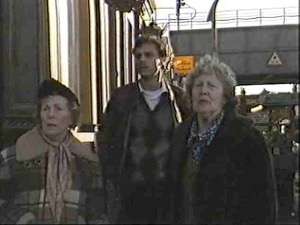
Fig.1. Looking across Albert Square towards Reg’s flat
Ethel Skinner (Gretchen Franklin) and Lou Beale (Anna Wing) stand watching the goings-on on the other side of Albert Square’s tiny central park, and Saeed Jeffery (Andrew Johnson) comes to join them from his shop, situated a few doors away behind them. Saeed expresses his concern about what may have happened to Reg, but Lou pointedly rejects him, saying “we look after our own.” This sets up a racial division between white and Asian characters that will permit the serial to explore questions of inclusion and exclusion. As is often the case in soaps, the question is “What constitutes (this) community?”, and here that question is spatially dramatized in the three-shot of these characters. It is two against one.

Fig. 2. The second iteration
Once Lou and Ethel have moved off and Saeed has stepped closer to the railings of Albert Square park, he is joined by his wife Naima (Shreela Ghosh) and Pauline Fowler (Wendy Richard) (Fig. 2). Naima tells Pauline that she and her husband Saeed had been the first to raise the alarm after Reg had failed to come into their shop for his regular purchase of milk. The issue of racial difference is developed as the sympathetic Pauline acknowledges the Asian shopkeepers as members of the community rather than outsiders. They are three together.
What we are beginning to see is a pattern of using frontal, often triangular arrangements of characters in a static shot. Spatial composition permits a sequence like this to privilege dialogue: we see the characters talking to each other. It also helps us to gain a deeper understanding of what is at stake for them because the shot privileges listeners’ reactions too. The significance of these exchanges is of course connected to the generic convention that gossip and conversation, secrets and revelations, are not only important in themselves but also encourage viewer speculation about future storylines and the viewer’s accumulation of knowledge about this fictional world.
Soap characters, in the goldfish bowl of their location, form alliances and rivalries, because of relationships based on many factors including family, work, age, race or gender. Since any one character will belong to more than one grouping, soap narratives can exploit permutations of connection and distinction between characters of different generations, sexes, races, families etc. Visual composition can express this, for example in Figure 3 in which three teenage children from different families meet in Albert Square and are connected compositionally by the three-shot.

Fig. 3. Ian Beale (Adam Woodyatt), Michelle Fowler (Susan Tully), Sharon Watts (Letitia Dean)
Interaction is not only about speech, but also silent reaction, and the three-shots that I am drawing attention to also privilege the work of the actor. They let the viewer get interested in performance, and expressivity as a key attraction of the programme. At the start of this episode as the news about Reg’s possible demise was spreading, Pauline had been informed by Dr Legg (Leonard Fenton) that she is unexpectedly pregnant with a third child. Dr Legg rushes off to help Reg, leaving the bemused Pauline and her stunned and silent husband Arthur (Bill Treacher) (Fig. 4). This three-shot expresses their inactivity and the eclipse of their concerns by Reg’s problems. Two wait in a space where they are visitors, while the one who controls this space can move.
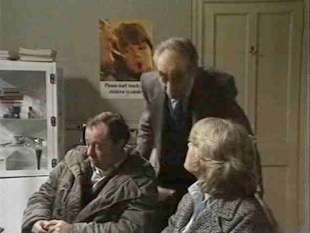
Fig. 4. Reg’s illness interrupts Dr Legg’s announcement
A little later (Figure 5), a three-shot establishes the tense relationship between Lou Beale and her daughter Pauline, with Arthur silent behind them. The launderette where this happens is Pauline’s workplace, where Lou and Arthur are visitors. Pauline is relatively empowered here, but Lou’s entry renders her (and Arthur) still and silent for a moment.
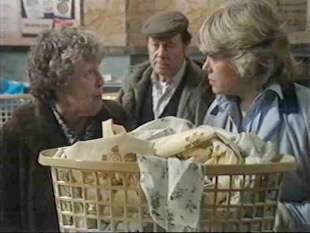
Fig. 5. Lou bursts into the laundrette.
Arthur, the silent man, is echoed by another silent man when Kathy Beale (Gillian Taylforth) accuses Sue Osman (Sandy Ratcliffe) and her husband Ali (Nejdet Salih) of not paying attention to the plight of their neighbour Reg (Fig. 6).
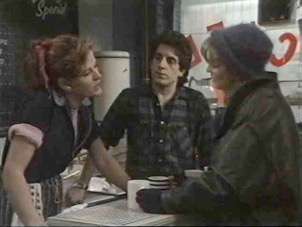
Fig. 6. A confrontation in the café.
The three-shot compositions direct our attention to the question of who has the power in a relationship or a location, and who is included and who is excluded from a grouping. Soap opera has of course been understood as a ‘feminine’ form, one aspect of which is the genre’s strong female characters. By means of three-shot compositions, the first episode of EastEnders announces this and explores its dynamics in different locations and among different groups of characters. Active women dominate or invade spaces, and often the men stand silently by. A group of three can comprise three linked characters, or two against one, and in the course of a single scene these links and splits can change.
Returning to the storyline about Pauline’s unexpected pregnancy, the episode moves inside the Fowlers’ home. Lou was furious when she found out that Pauline was pregnant with a third child, having already viewed her son-in-law Arthur with disappointment and exasperation. Her anger is rooted in her concerns for the family’s economic circumstances since Arthur is unemployed, and in another three-shot (Figure 7) Arthur becomes the silent target of her invective, with Pauline a silent observer.
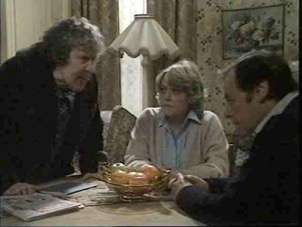
Fig. 7. Lou blames Arthur for the Fowlers’ woes.
But when Pauline’s and Arthur’s daughter Michelle gets involved, the three-shot is matched but reversed (Fig. 8). Whereas the matriarch Lou had occupied the elevated position, speaking from the left of the frame, now Michele is standing, arguing back against Lou from the right. The silent characters of Pauline and Arthur stay in shot, so that the viewer can experience the complexity of their reactions by examining the actors’ expressions.

Fig. 8. Michelle weighs in.
There are many more uses of this three-shot composition across the first episode of EastEnders, but I hope I have noted enough of them to make my case. The three-shot is clearly a deliberate directorial strategy, and although it is not especially foregrounded, once you notice it you cannot keep from spotting it again and again. It was not used for long in the early days of the soap opera, perhaps because it seems needlessly schematic. But it works as a spatial strategy in the production of the serial, very clearly and concretely establishing how social space expresses and contains the drama. Framing and composition are used systematically as expressive techniques.
Jonathan Bignell is Professor of Television and Film at the University of Reading. He currently leads the AHRC-funded research project “Spaces of Television: Production, Site and Style.” He has blogged on spatial themes for CST about the TARDIS in Doctor Who, and about the significance of cars in police drama.


